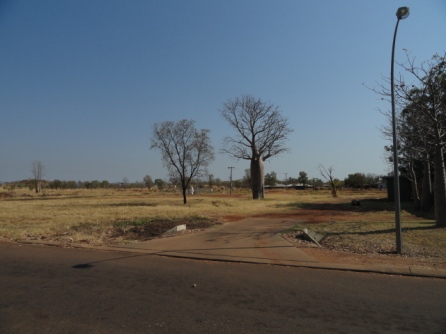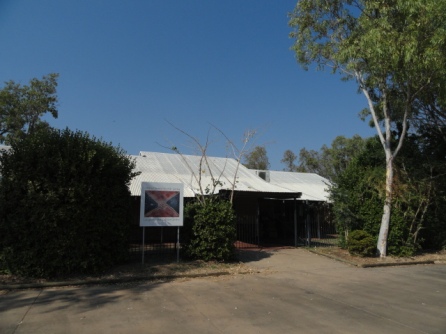Day 1. I arrive at Mirima Dawang Woorlab-gerring (MDWg) at 8am and the sun is already beating down.
MDWg is a small establishment on the outskirts of town neighbouring the Kimberley Land Council, Waringarri Aboriginal Arts Centre and Waringarri Radio. Hives of activity behind closed doors, in air condition rooms. The entrance is shaded by a generous garden. Turning around to look across the road my squinted gaze is met by a full-bellied boab tree and beyond this Ivanhoe Plains – a vast expanse of Kimberley bushland that seems to be shrivelling before my eyes. Bardenyirriny, the hot season, is only just doing its morning stretches!
Stepping inside the centre, a relative oasis, a fellow volunteer and I are met by the head linguist Knut Olawsky and some other members of the Mirima team. The language workers arrive and the introductory conversations continue. In one conversation I discover that ‘Sydney’ cannot be used at the moment, out of respect for a man from the community with that same name who has recently passed away. From now on I hail from ‘Harbour Town’.
Monday normally begins with a team meeting. Barefoot is the footwear of choice and I gratefully kick my sandals aside. We are formally introduced to the Mirima language workers. There are five language workers employed by MDWg and many have been around since the early days. These are Miriwoong men and women who are expanding their knowledge of the language, while also working on documentation of Miriwoong, the development of resources to teach the language and also other activities which contribute to the maintenance and revitalisation of the language such as the weekly radio show. Language documentation involves working alongside the handful of remaining fluent Miriwoong speakers to record language samples, transcribe these samples and with this large database of language develop a comprehensive understanding of the structure of the language, and ultimately a published Miriwoong grammar. In turn, comprehensive linguistic knowledge informs the production of resources such as videos, picture books and posters. Most of these resources can be used to teach both Miriwoong language and also cultural knowledge because culture is embedded in the vocabulary of the language.
One major challenge in revitalisation and maintenance contexts is that often the teacher is not far ahead of the students, especially if the students are young and absorb language at the same rate as red Kimberley earth absorbing raindrops. This may concern having appropriate teaching resources, linguistic knowledge or even a sufficiently extensive vocabulary. You might ask why the fluent Miriwoong speakers don’t take on the role of teaching? I will briefly discuss this here, however I will deal with the issue in greater depth down the track. In the case of Miriwoong, it isn’t feasible for elderly fluent speakers to be teaching school-aged students in a formal classroom context. Anyone who is a teacher knows how emotionally and physically draining teaching can be. Aside from using language in their own homes, these fluent speakers convey their linguistic knowledge in language documentation sessions as previously mentioned, and also during Master-Apprentice Language Learning sessions, in which they partner with the language workers to provide them with intensive language input, and promote fluent language use in everyday contexts. The teaching of language to kids* in the community is taken on by language workers, with the support of a facilitator, who (as I have mentioned) are in the process of extending their knowledge of the language, developing teaching materials and also exploring the possibilities of extending the vocabulary. Indeed one upcoming project which is mentioned at the morning meeting is vocabulary expansion.
Vocabulary expansion would involve the introduction of about 1000 words into Miriwoong to foster language use that is relevant to the modern world. The current lexicon consists largely of vocabulary to talk about traditional activities such as hunting, as well as rich vocabulary to describe the surrounding landscape, plants and animals. While the existing vocabulary is highly relevant to some aspects of everyday life, the western world has introduced a plethora of new objects and concepts which require description. Kids need vocabulary to talk about their toys, experiences at daycare, favourite games. Young adults need vocabulary to talk about parties, movies, football, girlfriends and boyfriends. The park rangers need vocabulary to discuss pest management. And so on an so forth. In short, if language revitalisation is to be successful, and Miriwoong is to be spoken across all generations within the community, then the language must provide the means to talk about the minutiae of everyday experience.
You may be asking yourselves, how exactly vocabulary expansion works? In answer to this question, expansion of vocabulary is a natural, adaptive process that occurs within languages. All languages have unique systems for developing new words to convey experience in an ever-changing world. An example that comes to mind is use of the word ‘lemon’, which I have recently learned can be used to refer to someone who is generally unpleasant or sour, and likely to put a dampner on good vibes. In this instance my English vocabulary has been expanded through the association of a new meaning to an existing word, which is metaphorically related to this additional meaning. Developing a large amounts of vocabulary in a short period of time is no easy task. The task involves working with linguistic resources available in Mirriwoong itself, or perhaps a neighbouring Aboriginal language or English if borrowing a word is appropriate. Mirriwoong has a system in place for borrowing nouns which involves adding a noun suffix to the ends of words. Another strategy might involve metonymy – naming a concept/thing using a word which is related in meaning to that concept/thing. Using ‘Harbour Town’ to refer to ‘Sydney’ is an example of this. For more on this topic have a look at “Gap Fillers” on this website developed by John Hobson and Susan Poetsch, linguists and educators who have worked in maintenance and revitalisation of Australian Aboriginal languages for many years, to provide guidance for the teaching of Australian Aboriginal languages.
Making changes to the original form of a language undergoing maintenance and revitalisation, such as the development of new vocabulary, must be approached with caution as this raises questions about the authenticity** of the language. How many changes can be made before a language is no longer that same language? For example, Rob Amery, a linguist with a longstanding commitment to the revitalisation of Kaurna, a South Australian language, points out that introducing a base-10 counting system into Kaurna was potentially problematic because this counting system was not only a new set of words, but also represented a different approach to conceptualizing and categorising the world. With the approval of Kaurna elders, the new counting system was introduced. From another perspective one might argue that, had Kaurna withstood the pressure of linguistic and cultural domination by English settlers, Kaurna speakers may have adapted their counting system in response to the changing world around them in a similar manner. What is important in the case of Kaurna is that community elders accept any changes to their language. It is their language after all, and agency at all stages in the process of language revitalisation ensures that this sense of ownership over the language, and identification with the language is protected.
For the Miriwoong language the circumstance are different in that there are remaining fluent speakers of the language and also partial speakers who have the final say on decisions related to language planning. As far as vocabulary expansion is concerned, close collaboration between a linguist, possessing expertise in the area of linguistic structures and processes, and speakers of the language would be essential. In fact no language sample is made available to the public without consulting these figures of authority. The MDWg project linguist Frances Kofod, having worked on Miriwoong for 30 years or more, speaks the language fluently and is also involved in the consultation process.
The morning meeting ends with a discussion of the appropriate word for long-necked turtle, which is the topic for the weekly radio show. There are a couple of different options, one possible word is a generic term for turtle and another is a term which may have come from a neighbouring language. The fluent speakers will need to be consulted before a final decision is made.
The remainder of day 1 is a kaleidoscope of new information and I leave work with my head spinning.
* At this point language is being taught to kids in the community through the mobile Language Nest. A team which includes language workers and a facilitator deliver Miriwoong immersion sessions to daycare groups and also some primary school classes as an extra-curricular activity. Based on the positive feedback from the schools, it is hoped that in the near future a full Miriwoong curriculum will be developed and ideally introduced into the schools as part of the LOTE (Languages Other than English) component of the general curriculum, as has been done for languages such as Gumbayngirr, which is a New South Wales language.
** I have only briefly touched on the issues of authenticity and authority here, however I want to emphasise that these are complex and highly salient issues where language maintenance and revitalisation is concerned. Furthermore the manner in which they are negotiated is unique to each different maintenance and revitalisation context.

